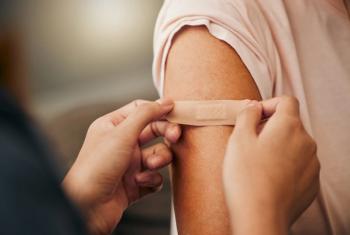Takeaways
- Lower sleep efficiency and higher sleep irregularity are associated with elevated hemoglobin A1C (HbA1c) and insulin resistance in adolescents and young adults with type 1 diabetes.
- Previous studies have shown that adolescents with type 1 diabetes often experience sleep disturbances, and this new research aims to explore the relationship between sleep characteristics, glycemic parameters, and endothelial functions in this population.
- The study, conducted with 22 participants aged 13 to 25, revealed that poor sleep quality is linked to lower flow-mediated dilation, indicating potential endothelial dysfunction.
- Significant associations were found between sleep duration variability and sleep efficiency with HbA1C levels, suggesting that variations in sleep patterns may impact glycemic control in individuals with type 1 diabetes.
- The study emphasizes the importance of addressing sleep-related factors as part of diabetes care and management strategies to improve overall health in adolescents and young adults with type 1 diabetes.
New research indicates that adolescents and young adults with type 1 diabetes who experience reduced sleep efficiency and increased sleep irregularity show elevated hemoglobin A1C (HbA1c) levels and insulin resistance.
In 2012, a study found adolescents with type 1 diabetes struggle with getting a full night of sleep—and spend more time in the night in light sleep than their non-diabetic peers.1 Meanwhile, a 2018 study found 23% of adolescents with type 1 diabetes reported having adequate sleep duration.2 The study ultimately found type 1 diabetes was associated with poorer sleep quality and a high prevalence of obstructive sleep apnea.
Another 2018 study found a relationship between poor sleep quality and early endothelial dysfunction, suggesting a link between sleep patterns, glycemic control, and endothelial dysfunction in type 1diabetes.3 Though, the link between the three had not been extensively researched in adolescents.
Thus, a new prospective cross-sectional study, led by Ornpisa Promsod, MD, of the department of pediatrics at Chulalongkorn University in Bangkok, Thailand, aimed to evaluate the associations between sleep characteristics, glycemic parameters, and endothelial functions in adolescents and young adults with type 1 diabetes.1
“The findings suggest that improving sleep might improve cardiovascular and metabolic outcomes in type 1 diabetes,” the investigators wrote. “While prior discussions focused on sleep deprivation interventions, efforts to improve sleep quality remain limited.”
The study, conducted at King Chulalongkorn Memorial Hospital from August to December 2022, included adolescent and young adults aged 13 – 25, diagnosed with type 1 diabetes. The study excluded individuals with previous sleep disorders, cardiovascular disease, renal disease, neurological or genetic conditions that could affect sleep, and unstable psychiatric conditions. After exclusion, the study included 22 participants. Participants had a mean age of 18.7 ± 3.4 years and over half (53%) were male. The mean hbA1C level was 7.6 ± 1.3%.
During the initial visit, the investigators collected the Pittsburgh Sleep Quality Index sleep questionnaire, which assessed subjective sleep quality. The questionnaire included the domains: sleep quality, sleep latency, sleep duration, sleep efficiency, sleep disturbances, use of sleeping medication, and daytime dysfunction. Scores ranged from 0 – 21, with scores >5 indicating poor sleep quality. Then, all participants received a physical examination.
The investigators gave participants continuous glucose monitors and wrist actigraphy devices. Participants had to wear the wrist device on their non-dominant wrist for a week to monitor sleep patterns. They had to note down when they went to bed (“light out”) and the time they woke up (“light on”). Participants also kept a daily sleep diary. After the week was up, participants returned to the hospital for flow-mediated dilation testing to access endothelial function.
The study’s outcome variables included age, age at diagnosis, diabetes duration, insulin therapy regimen, most recent hemoglobin A1C within the past 3 months, lipid profiles, microalbuminuria within the previous year, and medical history. Participants also self-reported their education level, cigarette smoking status, exercise habits, current medication use, and last menstrual period. Height, weight, waist circumference, and body mass index were also recorded.
The continuous glucose monitors showed a mean glucose level of 157.5 ± 34.1 mg/dL, and the mean estimated glucose disposal rate, which demonstrates insulin sensitivity, was 9.2 ± 1.5 mg/kg/min.
The mean sleep duration was 6.2 ± 1.0 h, which is lower than the 8 and 7 recommended hours of sleep for adolescents and adults, respectively. Meanwhile, sleep efficiency was 83.6 ± 5.9%, and the mean flow-mediated dilation was 6.5 ± 3.8%.
The study found for participants with poor sleep quality, the mean flow-mediated dilation was significantly lower than patients with good sleep quality (P = .03). Also, the study failed to find an association between continuous glucose monitor parameters, HbA1C level, estimated glucose disposal regulation, and flow-mediated dilation.
“Our study…did not find a correlation between glycemic parameters and [flow-mediated dilation], suggesting that poor sleep may be associated with [flow-mediated dilation] through other non-glycemic pathways,” the investigators wrote. “Further investigation is needed to explore additional factors that may contribute to the association between poor sleep and impaired [flow-mediated dilation] in individuals with type 1 diabetes.”
Though, the study showed significant associations between sleep duration variability and sleep efficiency with HbaA1C level. The higher sleep duration variability, the poorer the glycemic control (shown by the higher HbA1C levels) (P = .042).
Moreover, lower sleep efficiency was associated with poorer glycemic control (P = .039), insulin resistance (P = .014), and estimated glucose disposal rate (P =.001). Higher sleep midpoint irregularity was also associated with increased insulin resistance (P = .014).
Overall, HbA1C levels was significantly associated with sleep efficiency (β = 0.076; 95% CI, 0.145 – 0.008; P = .029) and sleep duration (β = 0.012; 95% CI, 0.001 – 0.023; P = 0.033).
“This study reveals the significant associations between sleep quality and endothelial function in adolescents and young adults with type 1 diabetes,” the investigators wrote. “Our results also highlight the potential impact of irregular sleep patterns on both insulin sensitivity and glycemic control emphasizing the need for addressing sleep related factors as part of diabetes care and management strategies for overall health.”
References:
- Promsod, O., Kositanurit, W., Tabtieang, T., Kulaputana, O., Chirakalwasan, N., Reutrakul, S., & Sahakitrungruang, T. (2023). Impact of irregular sleep pattern, and sleep quality on glycaemic parameters and endothelial function in adolescents and young adults with type 1 diabetes. Journal of Sleep Research, e14110. https://doi.org/10.1111/jsr.14110
- Drake, C. Poor Sleep for Young Diabetics Impairs Blood Sugar Control. HCPLive. January 3, 2012. https://www.hcplive.com/view/poor-sleep-for-young-diabetics-impairs-blood-sugar-control. Accessed December 1, 2023.
- Patel, N. J., Savin, K. L., Kahanda, S. N., Malow, B. A., Williams, L. A., Lochbihler, G., & Jaser, S. S. (2018). Sleep habits in adolescents with type 1 diabetes: Variability in sleep duration linked with glycemic control. Pediatric Diabetes, 19(6), 1100–1106.
- Farabi, S. S., Quinn, L., Phillips, S., Mihailescu, D., Park, C., Ali, M., & Martyn-Nemeth, P. (2018). Endothelial dysfunction is related to glycemic variability and quality and duration of sleep in adults with type 1 diabetes. The Journal of Cardiovascular Nursing, 33(4), E21–E25.
A version of this article was initially published by our sister publication, HCP Live.











